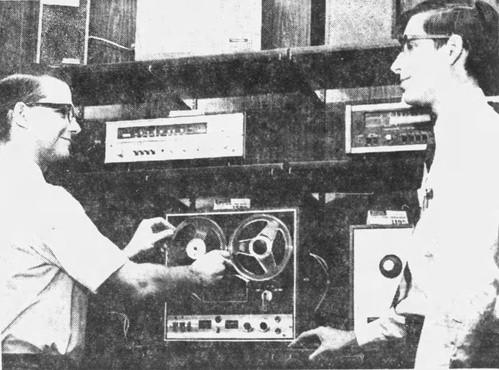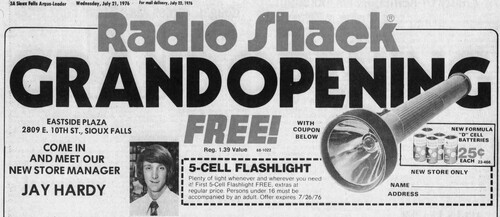Radio Shack
3410 S. Western
4001 W. 41st St. Empire Mall
2809 E. 10th
1700 S. Minnesota (Computer Center)
1612 E. 10th
5615 East Arrowhead Pkwy
4001 W. 41st St. Empire Mall
2809 E. 10th
1700 S. Minnesota (Computer Center)
1612 E. 10th
5615 East Arrowhead Pkwy
Radio Shack was a staple of American life for much of the 20th century and well into the 21st. In Sioux Falls Radio Shack lasted from 1968 to 2015.
The first Radio Shack store came in to existence in Boston in 1921. It was established by Theodore and Milton Deutschmann as a retail outlet for amateur or ham radio enthusiasts. The company was named after the structures aboard ships which held all the radio equipment. Amateur radio was really taking off in the early 20s, and the Deutschmanns were able to tap into this fervor with one retail outlet and eventually a thriving mail-order business. Radio Shack sent out its first catalog in 1939 as it began diversifying into high-fidelity music. By 1954, Radio Shack started selling its own branded stereo equipment under the name Realist. The company was forced to change the brand name to Realistic after being sued by a company called Stereo Realist, which made stereo cameras - cameras which would allow users to essentially take their own View-Master pictures. In the early 1960s, Radio Shack fell on hard times and careened toward bankruptcy. It was at that point that Charles D. Tandy entered the picture.
From the age of 12, Charles Tandy had worked in his father’s leather business. While serving in the US Navy during World War II, he noticed sailors doing needlepoint and knitting as recuperative therapy. Tandy thought the men might prefer working with leather as their medium, and established a system of craftwork involving leather for the sailors’ recuperation. After the war, Tandy took this concept, named it Tandycraft, and turned it into what would become a major part of his father’s business. In 1963, Tandy acquired the ailing Radio Shack for $300,000, seeing the potential in the company. At the time, Radio Shack consisted of the mail-order business and nine retail stores around Boston.
Tandy shut down the mail-order business, ended credit purchases, slimmed down top management, and streamlined the product line from 40,000 items to 2,500. He used data from mail-order purchases to select markets in which to expand. Managers of the stores were required to take an ownership stake in their location as incentive to remain profitable. Radio Shack grew quickly with Tandy’s hand at the wheel.
From the age of 12, Charles Tandy had worked in his father’s leather business. While serving in the US Navy during World War II, he noticed sailors doing needlepoint and knitting as recuperative therapy. Tandy thought the men might prefer working with leather as their medium, and established a system of craftwork involving leather for the sailors’ recuperation. After the war, Tandy took this concept, named it Tandycraft, and turned it into what would become a major part of his father’s business. In 1963, Tandy acquired the ailing Radio Shack for $300,000, seeing the potential in the company. At the time, Radio Shack consisted of the mail-order business and nine retail stores around Boston.
Tandy shut down the mail-order business, ended credit purchases, slimmed down top management, and streamlined the product line from 40,000 items to 2,500. He used data from mail-order purchases to select markets in which to expand. Managers of the stores were required to take an ownership stake in their location as incentive to remain profitable. Radio Shack grew quickly with Tandy’s hand at the wheel.

Manager Sherman Brondersley shows clerk Dexter Lorien the operation of a reel-to-reel tape deck at the first Store opened in Sioux Falls.
On March 3, 1968, Tandy Corporation announced a new complex of stores in Sioux Falls, to be built at the northeast corner of 42nd and Western, just east of the new Western Mall. The complex would include Radio Shack, Color Tile Supermart, and Tandycrafts - all of which were Tandy Corporation properties. General contracting was handled by Gil Haugan Construction. Radio Shack opened its doors on June 26, 1969, with amazing deals on radios, home intercom systems, reel-to-reel recorders, and more. A battery club card could be had for the asking, and each proud member of this club could receive a fresh, new battery once a month upon presentation of the card. At this time the Tandy Corporation owned over 650 Radio Shack locations across the country.
A second Radio Shack opened in the new Empire Plaza in September, 1975. This location was smaller, but if you were at the mall anyway (and who wasn’t, back when malls were popular), it was more convenient.
A second Radio Shack opened in the new Empire Plaza in September, 1975. This location was smaller, but if you were at the mall anyway (and who wasn’t, back when malls were popular), it was more convenient.

Less than a year later, a third location popped up in the Eastside Plaza at the southwest corner of 10th and Thompson, with a grand opening date of July 21, 1976. At this time, Radio Shack had over 4,600 stores in the US and Canada.
In early 1983, Radio Shack opened a computer store at 1700 S. Minnesota. It was a place to attend computer camps and take classes to learn about these new-fangled computer things the kids were into. Radio Shack had introduced one of the first mass-marketed personal computers in 1977. The TRS-80, named for Tandy Radio Shack and the Zilog Z80 processor, was ground-breaking in its marketing only; it used a proprietary operating system, TRSDOS. This meant most of the software available for the machine could only be purchased through Radio Shack.
From the time it was purchased by Tandy, Radio Shack had grown exponentially, but perhaps it flew too close to the sun. Though it was always the place to go for diodes, resisters, and other electronic components, the sort of nerds who needed these things were eventually able to find them online and for less. By the late 1990s, the company had started to decline, and by early 2015, had filed for bankruptcy. Sioux Falls’ first Radio Shack at 3410 S. Western closed at the end of March of that year, as did the Empire Mall location. Now there are very few locations left across the US, and most of them are in smaller communities. Maybe they’ll bounce back with a major re-structuring. I for one could use a free battery for my venerable Flavoradio.
In early 1983, Radio Shack opened a computer store at 1700 S. Minnesota. It was a place to attend computer camps and take classes to learn about these new-fangled computer things the kids were into. Radio Shack had introduced one of the first mass-marketed personal computers in 1977. The TRS-80, named for Tandy Radio Shack and the Zilog Z80 processor, was ground-breaking in its marketing only; it used a proprietary operating system, TRSDOS. This meant most of the software available for the machine could only be purchased through Radio Shack.
From the time it was purchased by Tandy, Radio Shack had grown exponentially, but perhaps it flew too close to the sun. Though it was always the place to go for diodes, resisters, and other electronic components, the sort of nerds who needed these things were eventually able to find them online and for less. By the late 1990s, the company had started to decline, and by early 2015, had filed for bankruptcy. Sioux Falls’ first Radio Shack at 3410 S. Western closed at the end of March of that year, as did the Empire Mall location. Now there are very few locations left across the US, and most of them are in smaller communities. Maybe they’ll bounce back with a major re-structuring. I for one could use a free battery for my venerable Flavoradio.
©www.GreetingsFromSiouxFalls.com
